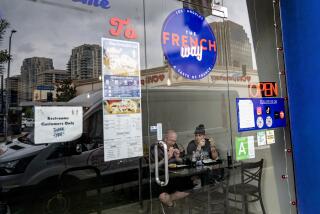Mexican History With French Accent : Culture: Architecture and baguettes hint at Santa Rosalia’s past. Such sights are unexpected on this peninsula, where fishing villages and desert flora are the norm.
- Share via
SANTA ROSALIA, Mexico — A stroll around this dusty but colorful city of 15,000 can be culturally confusing.
First, there’s the church designed by Alexandre Gustave Eiffel (of Eiffel Tower fame). Then there’s the bakery specializing in baguettes. And, finally, there are the sweeping porches and balconies of French colonial architecture.
The French occupied Mexico in the 1860s and left their mark in places throughout the country. Eiffel even designed buildings in other parts of Latin America.
But such vestiges are unexpected on this peninsula, where fishing villages and desert flora are the norm.
Twenty years after the French occupation, the French Compagnie du Boleo, a Rothschild venture, came to extract copper from the hills here and stayed until 40 years ago, adding French touches along the way.
Stores sold French-designed furniture and clothing, and restaurants served up coq au vin. Timber was imported to frame the clapboard homes in French design.
On a recent Sunday, Santa Rosalia’s streets are deserted save a few couples holding hands, some men sipping from beer bottles and lowrider trucks blaring Mexican polka music.
*
The doors of Panaderia El Boleo, which bakes its popular baguettes before light breaks, are closed.
Transit officer Carlos Araiza Ramirez walks his beat, greeting shop owners and townspeople, and aiding visitors who drive in circles looking for an exit to the maze of one-way streets.
“The tourists come here and are confused by the street signs,” he said, chuckling. “They go the wrong way down one-way streets, and when we tell them, they are embarrassed and apologetic. We tell them it’s OK.”
Mothers with children duck in and out of Eiffel’s cast-iron church, whose barrel-vault shape resembles a French train station. Eiffel built the church in 1887 for a European exposition. Later, it was dismantled and shipped to Santa Rosalia, nearly 600 miles south of San Diego.
The French left here in 1954, and the Mexican government continued to operate the mines until 1985, when a growing incidence of arsenic poisoning among mine workers and family members forced them to close. Several hundred yards north of the gateway to Santa Rosalia are the rusted shards of the once-thriving copper-smelting operation--railroad cars, tracks, smokestacks and pulleys--all flaking deep brown metal.
When the French were still here, they lived on the north bluff overlooking downtown, while Mexicans resided across the arroyo on the more pedestrian south bluff.
French administrators owned mansions with wide porches and wrought-iron gating, some of which now serve as city offices.
Many of the mansions are in disrepair, their paint chipping, balconies sagging. But the architecture is elegant and spacious.
At the 100-year-old Hotel Frances, where one can still rent a double for less than $20 a night, proprietor Roberto Manrique guides a visitor through oak-paneled rooms with cotton paisley wall coverings, where single French engineers once stayed.
Behind the hotel, one can see the mountains of coal-black sand, a byproduct from the smelting days, and the snaking stone causeway that connects the mines to the smokestacks. Manrique says the hotel’s antiquity and its French theme are big draws.
“All the people who come want to know about the history,” said Manrique, a portly man with a mustache who might be mistaken for a Frenchman.
*
Despite these sprinkled references to the French period, some fear Santa Rosalia’s history is slipping away.
Only one resident still speaks French, says city historian Miguel Angel Gomez, and there is no museum to capture the past, no French artisans, no French bistros or cafes. Most of the lore is passed along from teacher to student, grandparent to grandchild.
Gomez, who grew up listening to his grandparents’ stories, is on a quest to create some permanent record of the French influence.
“Very few people talk about it anymore,” said Gomez, 29. “All that’s left is for tourism. I wish they would offer some kind of exhibition to spark interest in this.”
More to Read
Sign up for The Wild
We’ll help you find the best places to hike, bike and run, as well as the perfect silent spots for meditation and yoga.
You may occasionally receive promotional content from the Los Angeles Times.






